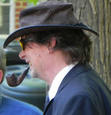Every student goes through it. They get to the bookstore, tell the assistant what course they are taking, and are given this incredibly large volume. When the student sits down and looks at the book, it is full of charts and exercises and other things, to the point that the student is totally discouraged. How, they ask themselves, am I supposed to use this book?
Textbook writers are not entertainers. Textbooks are not something you read when relaxing after dinner. They are large, very structured, full of information – in a word, boring. The purpose of the textbook is not the same as other books. Novels are written to entertain and inspire, non-fiction works are written to engage and inform, but textbooks are written to support a class. When reading a textbook, the purpose is not to learn everything in the book, but to prepare for a class by getting a first exposure to the information and by creating questions.
Process of Reading Textbooks
When reading a novel or some non-fiction work, the usual process is to read part of the book and then put it down, maybe to be reread at a later date. But reading a textbook is not done that way. When reading a textbook, a student should have a place to write down both notes and questions. Textbooks are very structured, and that structure should be used by the student to create a set of notes. These notes form the foundation of the student's participation in class.
The other goal while reading a textbook is to generate questions. What areas are not explained to the student's satisfaction? What examples need more detail? How does this material relate to previous and future material in the class? By having a set of questions, the student can pay closer and more purposeful attention to the classroom activity.
A chapter in a textbook should be read at least twice. The first time should be before the class, to get that first exposure and to generate the questions. Not everything will be understood in this reading, but that is to be expected. The second reading should occur within a day or two after the class. Is the material clearer now that the student has heard what the instructor had to say? What questions still remain? What new questions have been generated? What is still unclear? This second reading forms the basis of more personal discussions with the instructor, either during an appointment or through more casual contact.
Contents of a Textbook
Textbooks contain three basics types of information which need to be understood by the student. By looking for these materials, the student can get a firmer understanding of the content of a textbook.
The first type of information is conceptual. The concepts are the basic tenets and philosophies of the subject of the textbook. The goal with this material is to state clearly the concept involved and to analyze the support given to the concept. Textbooks do not simply state a concept; the author of a textbook usually attempts to justify the importance of the concept as well. The student needs to find and evaluate that justification.
The second type of information is application, often as a formula. These formulas become the basis of how the concepts are used in the field of the textbook. When working with a formula, the goals are to state each component of the formula and each variable's role in the problem.
The third type of information is examples. Most textbooks provide either formal or informal examples of how the concepts and formulas can be applied. The purpose of these examples is to clarify the applicability of the concepts and the usefulness of the formulas. When looking at an example, perhaps the most important consideration is the overall purpose of the example. The student should be asking themselves where this type of problem could occur in their life and their work.
Two Helpful Techniques
I have found that highlighting does not help the student very much. At one time or another, almost every sentence of the book becomes important enough to highlight. I have found that taking notes is much more valuable and effective. By writing something down, I have a much better chance of remembering it, and rewriting a concept forces me to clarify my understanding of what I have read.
However, there are always certain things that simply cannot be rewritten; for example, the explanations of formulas in a textbook are often the best explanations available. When I find a page in the textbook that I want to be able to return to quickly, I mark the page. Turning the corner of the page down is temporary at best and normally useless. Little pieces of paper fall out. What I have found most effective in marking pages is paper clips. They are large enough to find, and they stay in the book.
Reading textbooks can be the most effective way of learning material, but only if done correctly. Treating a textbook like any other book simply does not work, which discourages the student. However, if done correctly, the textbook can be a support tool for both the course and for later work.
John Steely has been teaching mathematics, study skills, and habits of success for over 25 years. You can access a number of free resources he has found and made at Steely Services

Post new comment
Please Register or Login to post new comment.